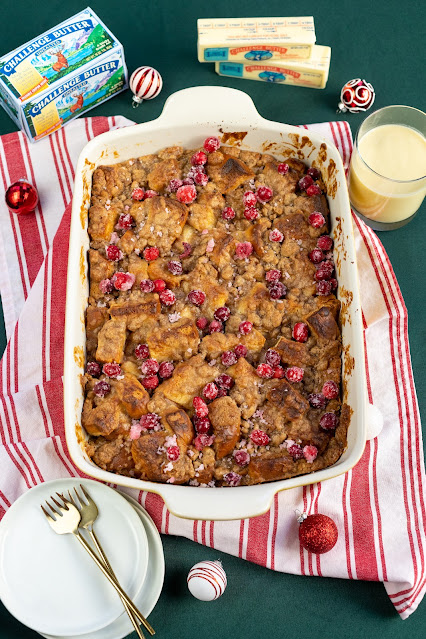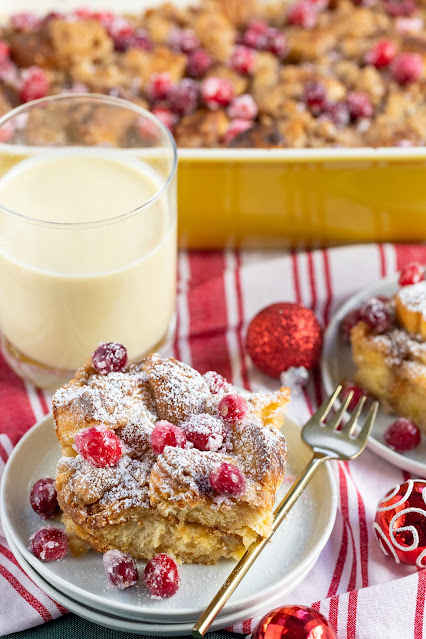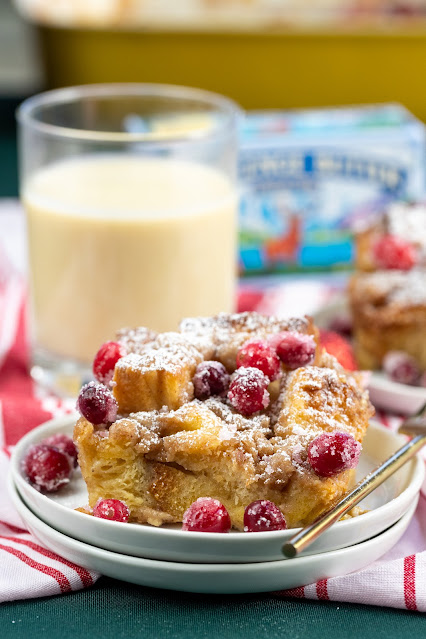This is a sponsored post by Challenge butter, but the text and opinions are all mine. Thank you for supporting brands that make Kylee's Kitchen possible!
Eggnog is the quintessential holiday drink. It’s thick and creamy with warm holiday spices—all things that pair really well with French toast! But no one wants to be stuck next to the stove making French toast all morning long while the rest of the family has fun opening presents.
The beauty of French toast casserole is that you can do all the prep work the night before and just pop it in the oven in the morning. So you get fluffy French toast full of delicious eggnog flavor without all the fuss.
The base of this recipe is homemade eggnog. You haven’t really had eggnog until you’ve had homemade eggnog. The store-bought drink tastes nothing like the real deal. In fact, I welcome you to make a double batch of the eggnog recipe below so you have a little to sip on! I included directions for how to make the eggnog if you're just using it for the casserole and how to make it if you plan to drink some as well because you have to heat the eggs if you plan to drink it.
My French toast bread of choice is brioche. It’s an enriched bread and is made with butter and sugar, so in my opinion, it really takes the recipe over the top. However, you could also use challah or French bread. I like to cube it and dry it out either overnight air in the oven at a low temperature just like I would with bread pudding and dressing because dry bread soaks up the eggnog better.
For an extra decadent touch, I sprinkle the top with a brown sugar/butter mixture. I only use Challenge unsalted butter because Challenge uses the freshest 100% real pasteurized sweet cream and salt. That’s it. Nothing artificial or synthetic.
At this point, you can either cover the entire casserole and bake it the following morning or you can bake it right away. It just depends on what works best for your schedule.
Before serving the French toast casserole, I like to dust each piece with a little powdered sugar and sprinkle candied cranberries on top for an extra festive pop of color!
Eggnog French Toast Casserole
Ingredients
For the eggnog
- 7 egg yolks
- 1/2 cup granulated sugar
- 2 1/2 cups heavy cream
- 2 cups whole milk
- 1/2 teaspoon ground nutmeg
- 1/2 teaspoon ground cinnamon
- 1/8 teaspoon ground cloves
- 1 Tablespoon vanilla
- 1/4 teaspoon salt
For the French toast
- 1 large loaf (16 ounces) brioche, challah or French bread, cubed and dried out overnight
- 1/2 cup (60 grams) all-purpose flour
- 1/2 cup (110 grams) brown sugar
- 1/2 t nutmeg
- 1/2 t cinnamon
- 1/4 cup (4 Tablespoons) Challenge unsalted butter, melted
- Optional: candied cranberries, powdered sugar for decorating
Directions
For the eggnog
If you're only planning to use it in the casserole
- Whisk together egg yolks and sugar.
- Add heavy cream, whole milk, nutmeg, cinnamon, cloves, vanilla, and salt.
- Whisk together egg yolks and sugar for about 1 minute, or until mixture is pale yellow.
- In a saucepan, combine heavy cream, whole milk, nutmeg, cinnamon, and cloves.
- Cook over medium heat until it starts to steam and edges start to bubble.
- Temper the egg yolk/sugar mixture by slowly pouring 1 cup of the milk/cream mixture into the egg yolk/sugar mixture and whisking vigorously.
- Then pour all of the egg yolk/sugar mixture back into the saucepan while whisking.
- Cook over low heat while whisking for about 3 minutes, or until mixture starts to thicken.
- Remove from heat and whisk in vanilla and salt.
- Allow to cool for several hours before drinking.
For the French toast
- Preheat oven to 350 degrees Fahrenheit.
- Prepare 9x13-inch baking dish with nonstick spray.
- Place bread cubes in baking dish. Pour eggnog on top, making sure all of the bread cubes are saturated.
- Mix together flour, brown sugar, nutmeg, cinnamon, and melted butter. Crumble topping over bread cubes.
- Bake French toast casserole for about 45 minutes, or until top is slightly browned, egg mixture is cooked, and internal temperature is 160 degrees Fahrenheit.
- Let cool for 10 minutes before serving.
- Dust with powdered sugar or add candied cranberries on top if desired.
.png)





















